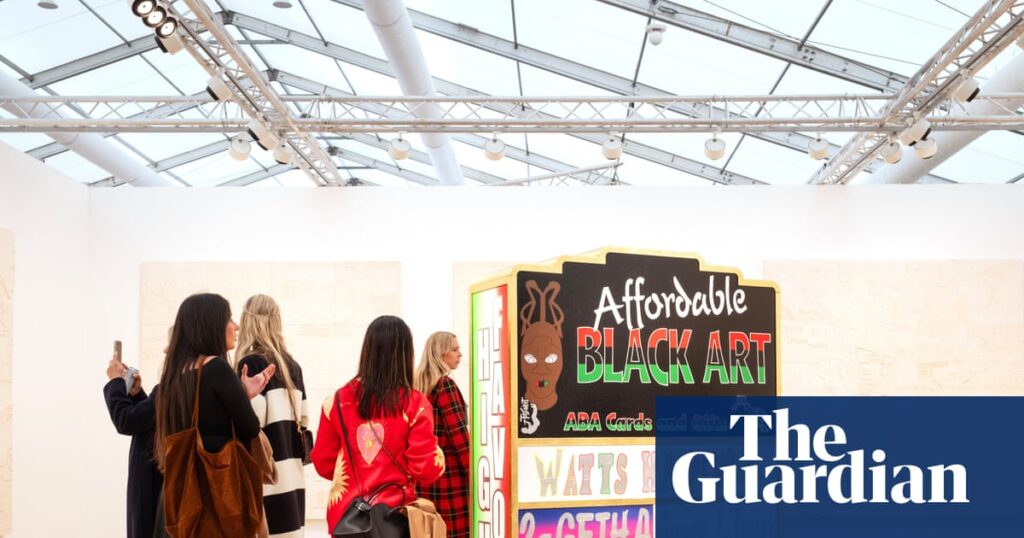“When you are at the art fair, you push the fashion to be bold and experiment – no black allowed,” says Belma Gaudio, at the opening of Frieze art fair in London.
Gaudio is the founder of fashion boutique Koibird and an art collector, and carries a bright green Hermès bag, and her own knitted co-ords with pictures of insects to make her point.
Fashion and art are familiar bedfellows but the relevance of fashion at Frieze, where more than 300 galleries and artists ranging from Lauren Halsey to Gilbert & George display works, has grown over the last decade.
Crucially, unlike fashion week where an invite is essential, anyone can go along to Frieze – if they pay about £60 for a ticket. This “real people” factor is catnip for fashion street style.
At the fair this October, the crowd mixed neutrals with pops of colour. The art crowd are often well-heeled, so the signs of the super-rich – Birkin bags, discreet cosmetic surgery and even fur coats – were in evidence, alongside a stylish, creative crowd. Attention-grabbing outfits mixed with fashion-literate but more low-key looks.
Charlene Prempeh, the founder of creative agency A Vibe Called Tech, is wearing all-black – but the sculptural shapes ensure her outfit fits in. “There’s very few occasions where you can get dressed up for a day event,” she says. “That’s what the fair facilitates.”
Too many overt blue-chip symbols turn some of the crowd off. Osman Ahmed, a writer wearing a Prada skirt and Alaïa bag, says he tones his look down at Frieze: “When there’s so much wealth and status signifiers in the room, I don’t want to be associated with that.”
Fashion brands, however, perhaps see an opportunity. Dunhill, Stone Island, Loewe and Nanushka are partners, meaning their branding will appear at the fair.
Talking to the Financial Times, both Dunhill and department store Dover Street Market said they often saw increased footfall during Frieze week.
“[It] is both a fashion and art moment,” says Gaudio. Koibird launched a collection from artist James Shaw in store this week.
Prada is perhaps the artiest of fashion brands. Last year, co-creative director Raf Simons told Vogue that “my interest in art is much bigger than my interest in fashion.”
For Frieze week, it has opened Prada Mode, a space in King’s Cross.
It features an installation by Danish contemporary art duo, Elmgreen & Dragset, entitled The Audience.
Visitors will walk into a “cinema” to watch an intentionally blurred film. Along with other people, they will share the space with five hyper-real sculptures sitting in the seats. One, of course, is wearing Prada.
It’s a full circle moment for the artists. Twenty years ago, they erected Prada Marfa, a replica of a Prada store, in the Texas desert. The project, originally a comment on the pomposity of land art, has since become an Instagram spot – Beyoncé and Solange posted selfies in 2012 – and it was in The Simpsons in 2019.
Although it wasn’t a collaboration with the brand, Prada gave permission for the artists to use the logo, and provided Prada designs to fill the store.
“In an informal way, that was our first collaboration,” says Michael Elmgreen. “It’s the [autumn/winter] 2005 collection, which happened to be in very desert-friendly coloured tones. They fit tremendously well in the desert landscape.”
Two decades on from Prada Marfa, JW Anderson had two paintings by Jean Siméon Chardin on the walls of the venue for his Dior show in June, Roksanda Ilinčić was inspired by Barbara Hepworth for her latest collection, and a sculpture by Kwangho Lee was on the catwalk at Bottega Veneta.
Artists are also inspired by fashion. Naomi Lulendo, exhibiting at the fair for the first time and wearing a striking outfit of a striped Kenzo shirt and flowing skirt, uses fabric and clothes in her work.
“Clothing is projecting something,” she says, “and since everybody’s projecting something on to you, you have a kind of control … I like people to see me in a way I want to be seen.”
London-based designer Bianca Saunders also makes artwork. This October, she collaborated with the Tate on designs that use the work of William Blake.
Art is central to her practice. “Whenever I feel blocked, I’m just like: ‘Let me do my rounds at the galleries,’” she says.
The artistic world is also inspiring. “When I first [started], I was like: ‘I want to see [people] walking around Frieze wearing the brand.’ That’s the customer that I want – for them to be observers of art.”
Elmgreen agrees that outfits are now part of the experience of Frieze.
“You can say it’s a fair for common people [because anyone can buy a ticket]. It’s not only for the selected few who have the money to buy the art … I think the fashion world is interested in a group of people that they can reach through the art.
“And the artist is definitely also interested in a group of people they can reach through the fashion world.”

